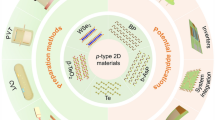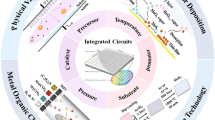Abstract
Improving charge transfer is the key to the performance of non-noble metal semiconductor-based surface enhanced Raman scattering (SERS) substrates. In this work, the O-incorporated 1T-MoS2 nanosheets with rich sulfur defects (ID-MoS2) are obtained by simple calcination of 1T-MoS2 nanosheets in air atmosphere. Using rhodamine 6G (R6G) as typical probe molecules, ID-MoS2 nanosheets show ultrahigh Raman enhancement effects with an enhancement factor of 1.24 × 107 due to sulfur defects and O incorporation in the 1T-MoS2 lattice. First-principle density functional theory calculations suggest that the existence of sulfur defects and O incorporation significantly increase the Fermi energy level (Ef) and electronic density of states of ID-MoS2. Moreover, O incorporation can enhance the interactions between the substrate and the adsorbed molecules through electrostatic and hydrogen bonding. All these improve the charge transfer resonance and result in the remarkable SERS activity of ID-MoS2 nanosheets. This is the first study on the increasing SERS performance of semiconductor substrates by simultaneously employing defect and dopant incorporation. This study provides an approach to optimize the performance of semiconductor-based SERS substrates.







Similar content being viewed by others
References
Yu B, Cao C, Li P, Mao M, Xie Q, Yang L (2018) Sensitive and simple determination of zwitterionic morphine in human urine based on liquid–liquid micro-extraction coupled with surface–enhanced Raman spectroscopy. Talanta 186:427–432
Xu J, Wu D, Li Y, Xu J, Gao Z, Song YY (2018) Plasmon-triggered hot-spot excitation on SERS substrates for bacterial inactivation and in situ monitoring. ACS Appl Mater Interfaces 10:25219–25227
Zhou W, Tian YF, Yin BC, Ye BC (2017) Simultaneous surface-enhanced Raman spectroscopy detection of multiplexed microRNA biomarkers. Anal Chem 89:6120–6128
Hu Y, Cheng H, Zhao X, Wu J, Muhammad F, Lin S, He J, Zhou L, Zhang C, Deng Y, Wang P, Zhou Z, Nie S, Wei H (2017) Surface-enhanced Raman scattering active gold nanoparticles with enzyme-mimicking activities for measuring glucose and lactate in living tissues. ACS Nano 11:5558–5566
Feng S, Hu Y, Ma L, Lu X (2017) Development of molecularly imprinted polymers-surface-enhanced Raman spectroscopy/colorimetric dual sensor for determination of chlorpyrifos in apple juice. Sens Actuators B Chem 241:750–757
Phan-Quang GC, Lee HK, Phang IY, Ling XY (2015) Plasmonic colloidosomes as three-dimensional SERS platforms with enhanced surface area for multiphase sub-microliter toxin sensing. Angew Chem Int Ed 54:9691–9695
Vantasin S, Ji W, Tanaka Y, Kitahama Y, Wang M, Wongravee H, Gatemala H, Ekgasit S, Ozaki Y (2016) 3D SERS imaging using chemically synthesized highly symmetric nanoporous silver microparticles. Angew Chem Int Ed 55:8391–8395
Kubackova J, Fabriciova G, Miskovsky P, Jancura D, Sanchez-Cortes S (2015) Sensitive surface-enhanced Raman spectroscopy (SERS) setection of organochlorine pesticides by alkyl dithiol-functionalized metal nanoparticles-induced plasmonic hot spots. Anal Chem 87:663–669
Wang Y, Yan B, Chen X (2013) SERS tags: novel optical nanoprobes for bioanalysis. Chem Rev 113:1391–1428
Boltasseva A, Atwater HA (2011) Low–loss plasmonic metamaterials. Science 331:290–291
Huang XQ, Tang SH, Mu XL, Dai Y, Chen GX, Zhou ZY, Ruan FX, Yang ZL, Zheng NF (2011) Freestanding palladium nanosheets with plasmonic and catalytic properties. Nat Nanotechnol 6:28–32
Phan-Quang GC, Lee HK, Phang IY, Ling XY (2015) Plasmonic colloidosomes as three-dimensional SERS platforms with enhanced surface area for multiphase sub-microliter toxin sensing. Angew Chem Int Ed 127:9827–9831
Zhang QQ, Li XS, Ma Q, Zhang Q, Bai H, Yi WC, Liu JY, Han J, Xi GC (2017) A metallic molybdenum dioxide with high stability for surface enhanced Raman spectroscopy. Nat Commun 8:14903
Zhang QQ, Li XS, Yi WC, Li WT, Bai H, Liu JY, Xi GC (2017) Plasmonic MoO2 nanospheres as a highly sensitive and stable non-noble metal substrate for multi-component surface-enhanced Raman analysis. Anal Chem 89:11765–11771
Chen JL, Sun K, Zhang Y, Wu D, Jin Z, Xie FZ, Zhao XL, Wang XF (2019) Plasmonic MoO2 nanospheres assembled on graphene oxide for highly sensitive SERS detection of organic pollutants. Anal Bioanal Chem 411:2781–2791
Cong S, Yuan YY, Chen ZG, Hou JY, Yang M, Su YL, Zhang YY, Li L, Li QW, Geng FX, Zhao ZG (2015) Noble metal-comparable SERS enhancement from semiconducting metal oxides by making oxygen vacancies. Nat Commun 6:8800
Zheng ZH, Cong S, Gong WB, Xuan JN, Li GH, Lu WB, Geng FX, Zhao ZG (2017) Semiconductor SERS enhancement enabled by oxygen incorporation. Nat Commun 8:1993
Wu WD, Chen JL, Ruan YE, Sun K, Zhang KH, Xie WJ, Xie FZ, Zhao XL, Wang XF (2018) A novel sensitive and stable surface enhanced Raman scattering substrate based on a MoS2 quantum dot/reduced graphene oxide hybrid system. J Mater Chem C 6:12547–12554
Ye YT, Bai H, Li MC, Tian Z, Du RF, Fan WH, Xi GC (2019) Construction of sensitive surface-enhanced Raman spectroscopy chip with sub-nanometer WO3−x nanowire-based superstructures for multicomponent detection. Adv Mater Technol 4:1900282–1900289
Zhou CL, Sun LF, Zhang FQ, Gu CJ, Zeng SW, Jiang T, Shen X, Ang DS, Zhou J (2019) Electrical tuning of the SERS enhancement by precise defect density control. ACS Appl Mater Interfaces 11:34091–34099
Wang X, Shi W, She G, Mu L (2011) Using Si and Ge nanostructures as substrates for surface-enhanced Raman scattering based on photoinduced charge transfer mechanism. J Am Chem Soc 133:16518–16523
Xie LM, Ling X, Fang Y, Zhang J, Liu ZF (2009) Graphene as a substrate to suppress fluorescence in resonance Raman spectroscopy. J Am Chem Soc 131:9890–9891
Qi DY, Lu LJ, Wang LZ, Zhang JL (2014) Improved SERS sensitivity on plasmon-free TiO2 photonic microarray by enhancing light-matter coupling. J Am Chem Soc 136:9886–9889
Lin J, Shang Y, Li XX, Yu J, Wang XT, Guo L (2017) Ultrasensitive SERS detection by defect engineering on single Cu2O superstructure particle. Adv Mater 29:1604797–1604810
Shi Y, Wang HY, Jiang XY, Sun B, Song B, Su YY, He Y (2016) Ultrasensitive, specific, recyclable, and reproducible detection of lead ions in real systems through a polyadenine-assisted, surface-enhanced Raman scattering silicon chip. Anal Chem 88:3723–3729
Wang XT, Shi WX, Wang SX, Zhao HW, Lin J, Yang Z, Chen M, Guo L (2019) Two-dimensional amorphous TiO2 nanosheets enabling high-efficiency photoinduced charge transfer for excellent SERS activity. J Am Chem Soc 141:5856–5862
Shang P, Zhang JN, Tang WY, Xu Q, Guo SJ (2016) 2D Thin nanoflakes assembled on mesoporous carbon nanorods for enhancing electrocatalysis and for improving asymmetric supercapacitors. Adv Funct Mater 26:7766–7774
Xie JF, Zhang H, Li S, Wang RX, Sun X, Zhou M, Zhou JF, Lou XW, Xie Y (2013) Defect-rich MoS2 ultrathin nanosheets with additional active edge sites for enhanced electrocatalytic hydrogen evolution. Adv Mater 25:5807–5813
Xie JF, Zhang JJ, Li S, Grote F, Zhang XD, Zhang H, Wang RX, Lei Y, Pan BC, Xie Y (2013) Controllable disorder engineering in oxygen-incorporated MoS2 ultrathin nanosheets for efficient hydrogen evolution. J Am Chem Soc 135:17881–17888
Wu W, Wang J, Ercius P, Wright NC, Leppert-Simenauer DM, Burke RA, Dubey M, Dongare AM, Pettes MT (2018) Giant mechano-optoelectronic effect in an atomically thin semiconductor. Nano Lett 18:2351–2357
Xie J, Xin J, Cui G, Zhang X, Zhou L, Wang Y, Liu W, Wang C, Ning M, Xia X (2016) Vertically aligned oxygen-doped molybdenum disulfide nanosheets grown on carbon cloth realizing robust hydrogen evolution reaction. Inorg Chem Front 3:1160–1166
Lin HF, Li YY, Li HY, Wang X (2017) Multi-node CdS hetero-nanowires grown with defect-rich oxygen-doped MoS2 ultrathin nanosheets for efficient visible-light photocatalytic H2 evolution. Nano Res 10:1377–1392
Sun Z, Zheng H, Li J, Du P (2015) Extraordinarily efficient photocatalytic hydrogen evolution in water using semiconductor nanorods integrated with crystalline Ni2P cocatalysts. Energy Environ Sci 8:2668–2676
Peng R, Liang L, Hood ZD, Boulesbaa A, Puretzky A, Ievlev AV, Come J, Ovchinnikova OS, Wang H, Ma C (2016) In-plane heterojunctions enable multiphasic two-dimensional (2D) MoS2 nanosheets as efficient photocatalysts for hydrogen evolution from water reduction. ACS Catal 6:6723–6729
Sandoval SJ, Yang D, Frindt R, Irwin J (1991) Raman study and lattice dynamics of single molecular layers of MoS2. Phys Rev B 44:3955–3958
Lukowski MA, Daniel AS, Meng F, Forticaux A, Li L, Jin S (2013) Enhanced hydrogen evolution catalysis from chemically exfoliated metallic MoS2 nanosheets. J Am Chem Soc 135:10274–10277
Liu Q, Shang QC, Khalil A, Fang Q, Chen SM, He Q, Xiang T, Liu DB, Zhang Q, Luo Y, Song L (2016) In situ integration of a metallic 1T-MoS2/CdS heterostructure as a means to promote visible-light-driven photocatalytic hydrogen evolution. ChemCatChem 8:2614–2619
Chang K, Hai X, Pang H, Zhang H, Shi L, Liu G, Liu H, Zhao G, Li M, Ye J (2016) Targeted synthesis of 2H- and 1T-Phase MoS2 monolayers for catalytic hydrogen evolution. Adv Mater 28:10033–10041
Wang Z, Rothberg LJ (2005) Origins of blinking in single-molecule Raman spectroscopy. J Phys Chem B 109:3387–3391
Acknowledgements
The authors would like to thank the US Department of Energy, Office of Basic Energy Sciences, Division of Chemical, Biological and Geological Sciences under Grant DE-FG02-86ER13622.A000 for support of this research.
Funding
This study was funded by Natural Science Foundation of Anhui Province (1908085QB73), the University Natural Science Foundation of Anhui Province (KJ2019A0773, KJ2019A0772), and the doctoral starting fundation of Anhui Jianzhu university (2019QDZ23).
Author information
Authors and Affiliations
Corresponding authors
Ethics declarations
Conflict of interest
The authors declare that there is no conflict of interest regarding the publication of this paper.
Additional information
Handling Editor: Avinash Dongare.
Publisher's Note
Springer Nature remains neutral with regard to jurisdictional claims in published maps and institutional affiliations.
Electronic supplementary material
Below is the link to the electronic supplementary material.
Rights and permissions
About this article
Cite this article
Zhou, X., Wu, D., Jin, Z. et al. Significantly increased Raman enhancement on defect-rich O-incorporated 1T-MoS2 nanosheets. J Mater Sci 55, 16374–16384 (2020). https://doi.org/10.1007/s10853-020-05172-7
Received:
Accepted:
Published:
Issue Date:
DOI: https://doi.org/10.1007/s10853-020-05172-7




